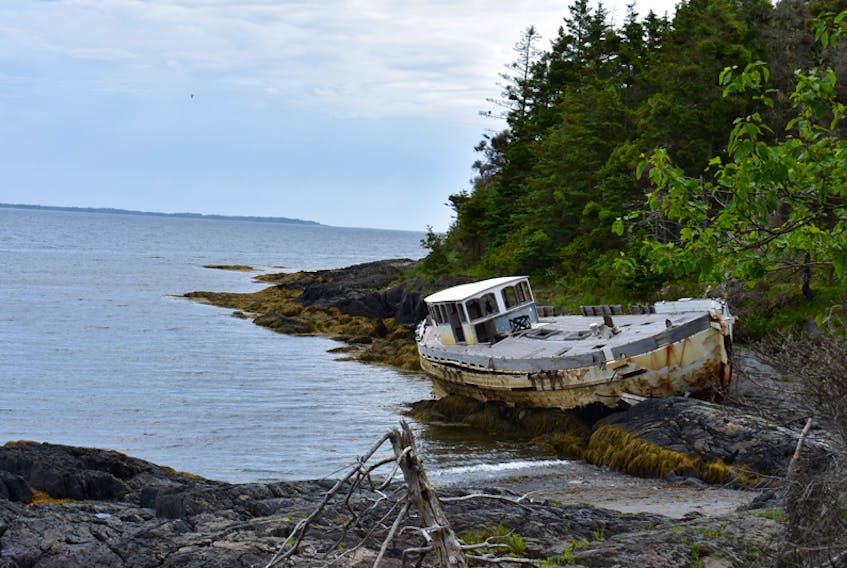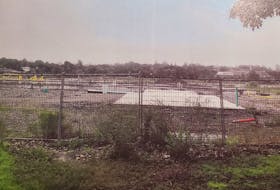EDITOR’S NOTE: This is part of a series profiling abandoned and derelict vessels across the South Shore.
Time, wind and rogues have left their marks on the Schwalbe, a derelict vessel beached in the community of Feltzen South.
The boat was abandoned in Lunenburg four years ago and broke free from its moorings during a storm. It drifted across the harbour and, much to the chagrin of locals, has marred the coastal community ever since.
Tim Wentzell, a lobster fisherman and the president of the community’s small craft harbour, said the vessel has since been looted and smashed to pieces.
“She’s stripped,” he said. “Anything of any value has been taken from it.”
But Wenztell isn’t concerned with scavengers: he just wants the boat dealt with.
Community members like Wentzell and Judith Atkinson, both of whom can see the boat from their properties, have been calling for the Schwalbe’s removal for years.
The Coast Guard originally boarded the boat and removed any contaminants when it drifted to Feltzen South but Wentzell said he’s frustrated it still hasn’t been removed.
“If that vessel had washed up in the Town of Lunenburg, it would have been gone within a month,” he said.
“But this one ended up in a rural community and it’s still here.”
Through its $1.5 billion Oceans Protection Plan, the federal government has put programs in place to identify and remove abandoned and derelict vessels.
But as new programs, municipalities, communities and residents are still grappling with the process of dealing with vessels left to rot along their waterways.
MULTIPLE PROGRAMS AVAILABLE
The federal government launched two programs in 2016 to help communities address abandoned and derelict vessels.
The first is Transport Canada’s Abandoned Boats Program (ABP) which provides grants to assist in removing abandoned small boats posing a hazard in Canadian waters.
However, concerned communities or governments must apply for the program and have secured their own funding ahead of time.
Once an application is accepted, recipients are eligible to have 100 per cent of the assessment and 75 per cent of removal costs reimbursed.
As per Transport Canada’s website, a total of 30 boats were assessed in Nova Scotia between 2018 and 2019 through ABP.
Like the ABP, the Small Craft Harbours Abandoned and Wrecked Vessels Removal Program (SCH) reimburses eligible recipients 100 per cent of the assessment and 75 per cent of removal costs.
However, given SCH is operated by the federal Department of Oceans and Fisheries, the program is only available to small craft harbours and recipients must take ownership of vessels.
Benoit Mayrand, a communications advisor for Fisheries, Oceans and the Canadian Coast Guard, confirmed no vessels in Nova Scotia have ever been removed through the SCH program.
However, he did note that a total of 23 vessels have been removed across Canada over the last two years.
DO THE PROGRAMS GO FAR ENOUGH?
South Shore - St. Margarets MP Bernadette Jordan has worked on the abandoned and derelict vessels file since being voted into Parliament in 2015.
Although a spokesperson for the federal Department of Oceans and Fisheries was unable to confirm the scale of the issue across the South Shore, Jordan said the recent programs are an avenue to address a national problem.
The catch is that the onus is on communities like Feltzen South to seek help.
“We’re not going to go in and initiate it,” said Jordan during an interview following an announcement about the HMCS Cormorant. “The funding is there for people who want to remove the vessels.”
But despite the programs being available, Wentzell said the application process isn’t easy.
He explained that he'd been asked by several people to apply through the SCH program given his role with the local harbour but was restricted due to the Schwalbe’s location.
“People have asked me to do it but as the harbour authority, where we are (located), it’s outside of our water lot,” he said.
The other option, said Wentzell, is for another group to apply through the ABP but he wasn’t aware of any action on that front.
“It’s not an easy procedure,” he summarized.
There had been legal concerns about the Schwalbe given the boat was originally brought in from outside of Canada and, as LighthouseNOW reported in 2017, was owned by British citizen Charlie Holland.
Jordan said the Municipality of the District of Lunenburg (MODL) had been investigating the boat for some time but she thought any issues of legality had been resolved.
“They were concerned with some legal issues which we have since addressed with the minister’s office for transportation,” she said.
CHALLENGES AND MOVING FORWARD
However, MODL has received legal advice recommending that the municipality not intervene and accept any liability when it comes to the Schwalbe.
Communications Office Sarah Kucharski noted MODL had already spent considerable time researching the issue and determined it was the responsibility of the federal government to assist residents in applying for the ABP.
“We understand it’s a new program and we hope that given the concerns of local government, they will make the changes needed to help residents apply for the funding,” she wrote via email.
Kucharski added that MODL Mayor Carolyn Bolivar-Getson had also sent a letter to the federal government suggesting improvements to the programs to help applicants.
But another organization has made some progress.
In the winter of 2018, a team from the Nova Scotia Lands was asked to join a provincial team identifying abandoned and derelict vessels.
The team, in conjunction with other departments across the province, identified 30 boats for the ABP — including the Schwalbe — and assessments are currently underway.
Marla MacInnis, a media relations advisor for the province, confirmed Nova Scotia Lands is in the process of taking possession of the languishing boat.
“We have hired a marine surveyor and we expect to have an assessment finished by the end of summer. Once the assessment is reviewed and submitted, we will submit our plan to remove the vessel,” she said.
But whatever the outcome, Wentzell said it doesn’t matter who cleans up the derelict boat as long as its removed.
“This should of been cleaned up a long time ago,” he said.
“Just get it done.”
The series will continue next week and will examine further impacts of abandoned and derelict vessels across the South Shore.









